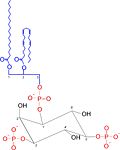Phosphatidylinositol 3,5-bisphosphate
Phosphatidylinositol 3,5-bisphosphate (also known as PI(3,5)P2) is a phospholipid that is present in the cell membrane of eukaryotic cells. It is a minor component of cell membranes, but plays a crucial role in various cellular processes, including intracellular trafficking, cytoskeleton organization, and cell growth and survival.
Structure[edit]
PI(3,5)P2 is a derivative of phosphatidylinositol (PI), a type of phospholipid that is abundant in cell membranes. It consists of a glycerol backbone, two fatty acid chains, a phosphate group, and an inositol ring. The inositol ring is phosphorylated at the 3 and 5 positions, hence the name "3,5-bisphosphate".
Function[edit]
PI(3,5)P2 is involved in a variety of cellular processes. It acts as a second messenger in signal transduction pathways, transmitting signals from the cell surface to the interior of the cell. It also plays a role in the regulation of ion channels and transporters, influencing the movement of ions and other substances across the cell membrane.
In addition, PI(3,5)P2 is involved in the regulation of intracellular trafficking. It is necessary for the formation of multivesicular bodies, which are involved in the sorting and degradation of proteins. It also plays a role in the formation of autophagosomes, which are involved in the degradation of cellular components during autophagy.
Furthermore, PI(3,5)P2 is involved in the organization of the cytoskeleton, influencing the arrangement of actin filaments and microtubules. It also plays a role in cell growth and survival, influencing processes such as cell proliferation, cell differentiation, and apoptosis.
Biosynthesis and regulation[edit]
The biosynthesis of PI(3,5)P2 is regulated by a complex of proteins known as the PIKfyve complex. This complex includes the enzyme PIKfyve, which phosphorylates PI3P to produce PI(3,5)P2. The activity of PIKfyve is regulated by various factors, including protein-protein interactions, post-translational modifications, and changes in cellular conditions.
Clinical significance[edit]
Alterations in the levels of PI(3,5)P2 have been associated with various diseases, including neurodegenerative diseases, cancer, and inflammatory diseases. Therefore, PI(3,5)P2 and the enzymes involved in its metabolism are potential targets for therapeutic intervention.
This cell biology related article is a stub. You can help WikiMD by expanding it.
-
Phosphatidylinositol-3,5-bisphosphate
Ad. Transform your life with W8MD's Budget GLP-1 injections from $75


W8MD offers a medical weight loss program to lose weight in Philadelphia. Our physician-supervised medical weight loss provides:
- Weight loss injections in NYC (generic and brand names):
- Zepbound / Mounjaro, Wegovy / Ozempic, Saxenda
- Most insurances accepted or discounted self-pay rates. We will obtain insurance prior authorizations if needed.
- Generic GLP1 weight loss injections from $75 for the starting dose.
- Also offer prescription weight loss medications including Phentermine, Qsymia, Diethylpropion, Contrave etc.
NYC weight loss doctor appointmentsNYC weight loss doctor appointments
Start your NYC weight loss journey today at our NYC medical weight loss and Philadelphia medical weight loss clinics.
- Call 718-946-5500 to lose weight in NYC or for medical weight loss in Philadelphia 215-676-2334.
- Tags:NYC medical weight loss, Philadelphia lose weight Zepbound NYC, Budget GLP1 weight loss injections, Wegovy Philadelphia, Wegovy NYC, Philadelphia medical weight loss, Brookly weight loss and Wegovy NYC
|
WikiMD's Wellness Encyclopedia |
| Let Food Be Thy Medicine Medicine Thy Food - Hippocrates |
Medical Disclaimer: WikiMD is not a substitute for professional medical advice. The information on WikiMD is provided as an information resource only, may be incorrect, outdated or misleading, and is not to be used or relied on for any diagnostic or treatment purposes. Please consult your health care provider before making any healthcare decisions or for guidance about a specific medical condition. WikiMD expressly disclaims responsibility, and shall have no liability, for any damages, loss, injury, or liability whatsoever suffered as a result of your reliance on the information contained in this site. By visiting this site you agree to the foregoing terms and conditions, which may from time to time be changed or supplemented by WikiMD. If you do not agree to the foregoing terms and conditions, you should not enter or use this site. See full disclaimer.
Credits:Most images are courtesy of Wikimedia commons, and templates, categories Wikipedia, licensed under CC BY SA or similar.
Translate this page: - East Asian
中文,
日本,
한국어,
South Asian
हिन्दी,
தமிழ்,
తెలుగు,
Urdu,
ಕನ್ನಡ,
Southeast Asian
Indonesian,
Vietnamese,
Thai,
မြန်မာဘာသာ,
বাংলা
European
español,
Deutsch,
français,
Greek,
português do Brasil,
polski,
română,
русский,
Nederlands,
norsk,
svenska,
suomi,
Italian
Middle Eastern & African
عربى,
Turkish,
Persian,
Hebrew,
Afrikaans,
isiZulu,
Kiswahili,
Other
Bulgarian,
Hungarian,
Czech,
Swedish,
മലയാളം,
मराठी,
ਪੰਜਾਬੀ,
ગુજરાતી,
Portuguese,
Ukrainian
